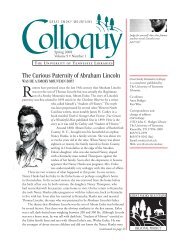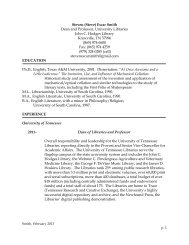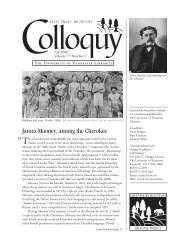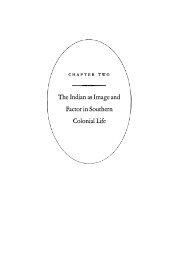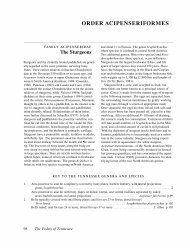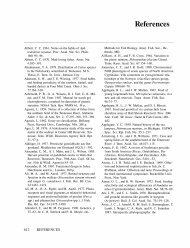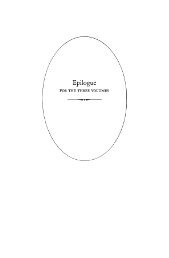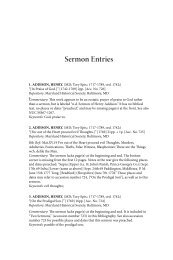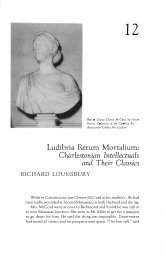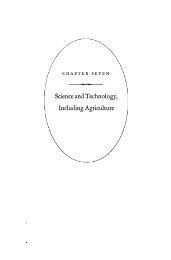Literature, Principally Belletristic - University of Tennessee, Knoxville
Literature, Principally Belletristic - University of Tennessee, Knoxville
Literature, Principally Belletristic - University of Tennessee, Knoxville
Create successful ePaper yourself
Turn your PDF publications into a flip-book with our unique Google optimized e-Paper software.
· INTELLECTUAL LIFE IN THE COLONIAL SOUTH '<br />
much more than they had in Parks' Maryland Gazette. For example, on<br />
July 27, 1737, dated from "Hanover, July 25" and signed "J.C.J[ohln<br />
C-s-y" appeared a ribald mock will, sexual and scatological, including such<br />
gems as "I give to the Poor <strong>of</strong> the Parish <strong>of</strong> Martin, / Three Bushels <strong>of</strong><br />
Wind, to be laid out in F-rt-ng." On February 10, 1737/8, one F.R. contributed<br />
lively verses against the bonds <strong>of</strong> matrimony. On October 20 in a<br />
sworn-as-true letter from a "William Thomas" <strong>of</strong> North Carolina to his<br />
Virginia father-in-law, the satire may be directed at the same Carolinians<br />
Byrd was to caricature : "As to my Transactions in America, I came as a<br />
Servant into Virginia, drubb'd my Master, ravish'd my Mistress, and ran<br />
away. I turn'd Weaver, married a wife, and soon killed her with Kindness."<br />
Then on November 24 "W.W." sent in a facetious short essay, "Instructions<br />
how to make a perfect Quaker," beginning "FIRST, Take a Handful<br />
<strong>of</strong> the Herb <strong>of</strong> Deceit, and a few leaves <strong>of</strong> Folly, and a little <strong>of</strong> the Rose <strong>of</strong><br />
Vain-Glory, with some <strong>of</strong> the Blossoms <strong>of</strong> Malice . .. :' and carrying it on<br />
to a complete recipe. More serious as well as stronger satire was to accom<br />
pany or take the place <strong>of</strong> such light mocking pieces in later issues.<br />
Before turning to the major satirist <strong>of</strong> the pre-1745 period, one should<br />
note that John Lawson in A New Voyage to Carolina (London, 1709)<br />
contributed to the southern humorous tradition <strong>of</strong> the tall tale. In describing<br />
the tulip tree and its "prodigious Bigness" he remarks that he has<br />
been informed <strong>of</strong> one <strong>of</strong> this species so large that "a lusty man had his<br />
Bed and Household Furniture, and lived in it, till his Labour got him a<br />
more fashionable Mansion. He afterwards became a noted Man, in his<br />
Country, for Wealth and Conduct." He passes on Indian stories <strong>of</strong> huge<br />
rattlesnakes which devoured canoes full <strong>of</strong> red men, or <strong>of</strong> one which bit<br />
a locust tree as thick as a man's arm and caused the tree to die. And there<br />
was the rattlesnake put into bed with a dying man. The next morning the<br />
man was found sound and healthy and the snake dead. Lawson certainly<br />
relishes the tall tale, but usually he is careful to differentiate those he believes<br />
to be true from the superstitions and lies <strong>of</strong> the red men. Dr. Brickell's<br />
The Natural History <strong>of</strong> North Carolina (Dublin, [1737]) , which<br />
owes most <strong>of</strong> its data to Lawson, adds a good deal <strong>of</strong> nature lore, as that<br />
whales copulate standing upright with their heads out <strong>of</strong> the water,<br />
though whether this is tongue-in-cheek reporting is not clear. Brickell also<br />
has additional stories <strong>of</strong> remarkable Indian medical cures. These, with<br />
the earlier George Alsop's and Robert Beverley's (The History and Present<br />
State <strong>of</strong> Virginia, 1705 ), as that <strong>of</strong> the Indian who brought rain for two<br />
bottles <strong>of</strong> rum, with other tales <strong>of</strong> conjuration regarded skeptically by the<br />
white narrator, helped to establish a comic as well as a supernatural folklore<br />
about the red man which was to persist in American literature.78



